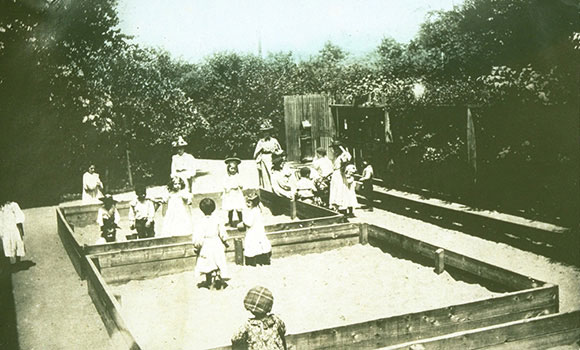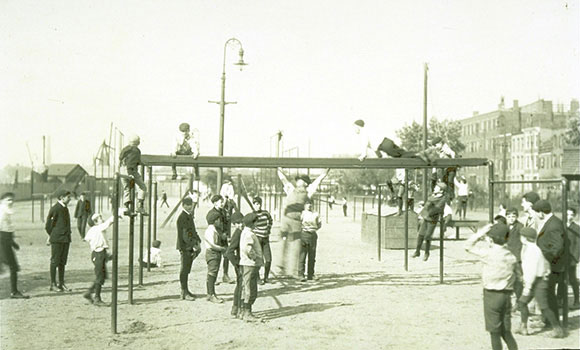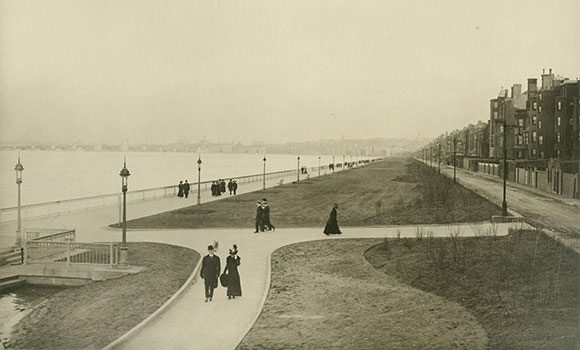History of the Esplanade
The Esplanade as we know it today is a relatively recent creation.
For millennia along the tidal Quinobequin River, now called the Charles River, indigenous inhabitants stewarded the site. History of recent centuries documents that the Massachusett people intersected with Nipmuc neighbors to the west and Wampanoag neighbors to the South. They fished in the river’s tides with weirs, traveled and traded along the waters, farmed and hunted on the land, and made their communities here. The arrival of European colonialists ultimately led to the violent displacement of the Massachusett people from what we now call Boston. The Neponset band of the Massachusett, for example, saw their territory diminished as they were forced over the Blue Hills to a smaller area of the Neponset Territory known as Ponkakpoag. While displaced, their name was adopted by the Commonwealth of Massachusetts, whose Department of Conservation and Recreation (DCR) now oversees the Charles River Esplanade among many public state parks and properties. Through its work in partnership with DCR, the Esplanade Association strives to honor, respect and recognize the connection between this site and our local indigenous tribes’ and neighbors’ ongoing stewardship of these lands and waters. To learn more from the Commonwealth about regional Native American resources and tribes, please visit here.
It was only in the second half of the nineteenth century that today’s Charles River waterfront took shape. The filling of Boston’s Back Bay occurred over decades, with Back Street and the adjacent seawall forming most of the northern edge by the 1870s. By the late 1880s and early 90s, renowned landscape architect and Brookline resident Frederick Law Olmsted had designed “Charlesbank” along the waterfront with a promenade and the first free public outdoor gymnasium to improve the health of residents of all ages living in disease-ridden tenements in the West End. At that time the river was still tidal and was considered a distinct liability because it was so foul smelling at low tide with the sewage of new Back Bay inhabitants! Damming of the Charles River basin in 1910 changed the odiferous mud flats into a wide basin with a constant water level. The Esplanade was born.
At first, this this edged the River with a narrow strip of parkland. By the mid 1930s, Olmsted’s protege, landscape architect Arthur Shurcliff, transformed and nearly doubled the parkland. This was the foundation of the park as it is today. Trees were planted, the water’s edge redesigned, canoe ways added, and docks, pathways, and monuments and venues constructed, including the Hatch Shell. Construction of Storrow Drive through the early 1950s brought further changes and the creation of additional features including the islands and lagoons to make up for parkland lost to the new road.
The park continues to evolve as a public recreation space. Since 2001 the Esplanade Association has worked in partnership with DCR to invest in park improvements including restoring historic landmarks, adding park programs and amenities, and revitalizing key gathering areas. See how our funds raised have accomplished numerous projects.
Today the Esplanade is considered the focal point of the Charles River Reservation and remains a vital green space for the city of Boston. With the support of the community, the Esplanade will continue to transform to serve future generations. Learn more about the Esplanade Association’s current once-in-a generation plan for the future of Charlesbank Landing.
Additional reading about the Esplanade:
Charles River Study Report
Esplanade Cultural Landscape Report by Sherry Page Berg
The Charles River Esplanade Our Boston Treasure by Linda M. Cox provides a historical overview of the Esplanade’s changing landscape as well as existing conditions and analysis.












